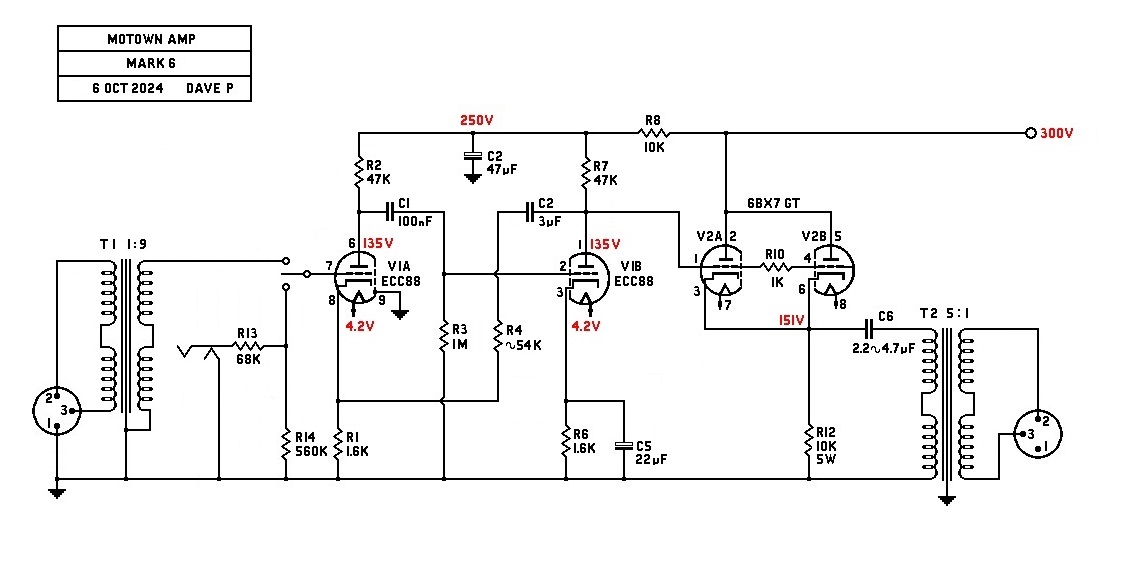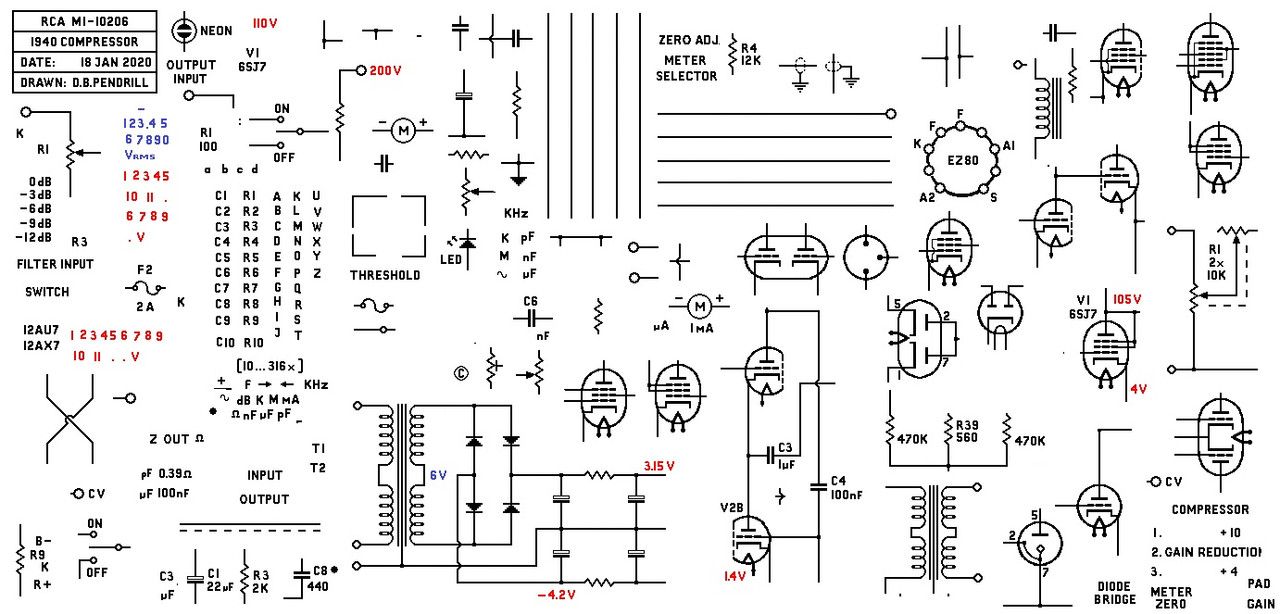You are using an out of date browser. It may not display this or other websites correctly.
You should upgrade or use an alternative browser.
You should upgrade or use an alternative browser.
Motown Direct Amplifier-inspired Preamp?
- Thread starter untune
- Start date
Help Support GroupDIY Audio Forum:
This site may earn a commission from merchant affiliate
links, including eBay, Amazon, and others.
MidnightArrakis
Well-known member
Brian Roth
Well-known member
Dave, what app are you using to draw your schematics? I like the look of them!
Bri
chrispbass
Well-known member
Dave, what app are you using to draw your schematics? I like the look of them!
Bri
I was thinking the same thing!
untune
Well-known member
Same technique I was using for the schematics at the start of the thread (albeit with Photoshop and a Pultec diagram) and I agree, there's just something relaxing about it!There is no app as such, you might notice the similarity to the original LA-2 schematic?
When I made an LA-2 back in 2008, I copied the schematic into MS Paint and after tidying it up, I have been using it ever since.
CJ has made the first practical version of this circuit with the tubes he had "in his sock drawer", being a 6N1P.
I made this combined chart to show the difference in the working point when using the 6N1P instead of the ECC88.

The green traces are the 6N1P @ OV, -2V, -4V, -6V and -8V, the orange traces are the same voltages for the ECC88.
The red line is the 47k load line.
The 6N1P has very curved lines down there compared to the ECC88. I think it is also more linear around the -4V working point.
This may make it more transparent, but maybe the 6N1P may have more "tone"?
best
DaveP
I made this combined chart to show the difference in the working point when using the 6N1P instead of the ECC88.

The green traces are the 6N1P @ OV, -2V, -4V, -6V and -8V, the orange traces are the same voltages for the ECC88.
The red line is the 47k load line.
The 6N1P has very curved lines down there compared to the ECC88. I think it is also more linear around the -4V working point.
This may make it more transparent, but maybe the 6N1P may have more "tone"?
best
DaveP
Last edited:
CJ
Well-known member
Dave do you think I should change that 10 K resistor on the cathode to get a voltage closer to your schematic?
I think around 150V is a safe cathode voltage for long life, but I guess its the plate voltage of the triode feeding it that is controlling the cathode voltage, that needs to be about 135V to give 150V at the cathode. Maybe lower the B+ for the final triode?CDave do you think I should change that 10 K resistor on the cathode to get a voltage closer to your schematic?
best
DaveP
CJ
Well-known member
CJ
Well-known member
CJ
Well-known member
CJ
Well-known member
here's where things get interesting, to me at least,
sq wave shots on the secondary of the output xfmr,
Dave's circuit has that transformer ringing a lot, is this because of the better sq wave response producing more harmonics or something? i doubt the transformers are different, they look like they came from the same lot,
remember the "sharper corners" comment up one post? i bet that is the reason for the ringing.
so a preamp that is lo-fi, with no NFB might be better when it comes to ringing in the transformer?
sq wave shots on the secondary of the output xfmr,
Dave's circuit has that transformer ringing a lot, is this because of the better sq wave response producing more harmonics or something? i doubt the transformers are different, they look like they came from the same lot,
remember the "sharper corners" comment up one post? i bet that is the reason for the ringing.
so a preamp that is lo-fi, with no NFB might be better when it comes to ringing in the transformer?
Attachments
CJ
Well-known member
ruffrecords
Well-known member
Ringing is indicative of a resonance. A good square wave will have more energy at the resonance than a poor one so will create more ringing. Perhap you need a secondary Zobel network to tame it.
Cheers
Ian
Cheers
Ian
Thank you CJ for all the work you have put into this project and especially for all the scope shots.
The V72 (and all the V series) had a feedback resistor bypass cap, 50pF plus 40pF variable, to tame the top end. They were trying to limit the pick-up of the tape head bias in the studios, so they limited the top end to 15kHz. Now that we don't use tape recorders so much, we can allow the response to 50kHz but I don't think we need 500kHz do we? I suppose grid stoppers would also do the trick?
best
DaveP
The V72 (and all the V series) had a feedback resistor bypass cap, 50pF plus 40pF variable, to tame the top end. They were trying to limit the pick-up of the tape head bias in the studios, so they limited the top end to 15kHz. Now that we don't use tape recorders so much, we can allow the response to 50kHz but I don't think we need 500kHz do we? I suppose grid stoppers would also do the trick?
best
DaveP
The voltages are looking much better now, the 6BX7 cathode voltage has come down, and the other cathode voltages have gone up, all much closer to the original working points.here are some new voltages after the 6N1P swap for the 12AX7a and some adjustments to the pwr supply,
input level was jacked up to 800 mx P-P, starts to clip at 1.5 V-RMS input>
Attachments
best
DaveP
MidnightArrakis
Well-known member
>> I just received the 2 - 6BX7's and the capacitor mounting-clamps I had ordered a few days ago in the mail yesterday. COOL!!!.....The voltages are looking much better now, the 6BX7 cathode voltage has come down, and the other cathode voltages have gone up, all much closer to the original working points.
best
DaveP
/
CJ
Well-known member
CJ
Well-known member
adding an 82 k stopper to the grids of the 6BX7 output tube helps even more,
now the ringing looks manageable
interesting that you can not see the ringing on the input of the transformer, it takes the transformer to make all that ringing happen from the hi freq response of the preamp,
theses shots are all 10 k hz,
now the ringing looks manageable
interesting that you can not see the ringing on the input of the transformer, it takes the transformer to make all that ringing happen from the hi freq response of the preamp,
theses shots are all 10 k hz,
Attachments
Similar threads
- Replies
- 8
- Views
- 1K
- Replies
- 7
- Views
- 1K
- Replies
- 5
- Views
- 551




























![Soldering Iron Kit, 120W LED Digital Advanced Solder Iron Soldering Gun kit, 110V Welding Tools, Smart Temperature Control [356℉-932℉], Extra 5pcs Tips, Auto Sleep, Temp Calibration, Orange](https://m.media-amazon.com/images/I/51sFKu9SdeL._SL500_.jpg)
























